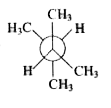Addition of HCl to 3,3-dimethyl-1-butene and reaction of HCl with 3,3-dimethyl-2-butanol give the same product. Explain,
To explain why the addition of HCl to 3,3-dimethyl-1-butene and the reaction of HCl with 3,3-dimethyl-2-butanol yield the same product, we can break down the reactions step by step.
Step 1: Structure of the Compounds
- 3,3-Dimethyl-1-butene has the following structure:
- It is a butene with a double bond between the first and second carbon atoms, and two methyl groups attached to the third carbon.
- 3,3-Dimethyl-2-butanol has the following structure:
- It is a butanol with an -OH (hydroxyl) group on the second carbon and two methyl groups attached to the third carbon.
Step 2: Reaction of HCl with 3,3-Dimethyl-1-butene
1. Protonation of the Alkene: The double bond in 3,3-dimethyl-1-butene acts as a nucleophile and attacks the H+ from HCl, leading to the formation of a carbocation.
2. Carbocation Formation: The proton adds to the less substituted carbon (C1), forming a secondary carbocation at C2 (due to the presence of two methyl groups at C3).
3. Rearrangement: The secondary carbocation can rearrange to a more stable tertiary carbocation through a 1,2-methyl shift. This involves one of the methyl groups from C3 moving to C2, resulting in a tertiary carbocation at C2.
4. Nucleophilic Attack: The chloride ion (Cl-) from HCl then attacks the tertiary carbocation, resulting in the final product.
Step 3: Reaction of HCl with 3,3-Dimethyl-2-butanol
1. Protonation of the Alcohol: The hydroxyl group (-OH) in 3,3-dimethyl-2-butanol is protonated by HCl, making it a better leaving group.
2. Carbocation Formation: The protonated alcohol loses water (H2O), forming a secondary carbocation at C2.
3. Rearrangement: Similar to the previous reaction, this secondary carbocation can also undergo a 1,2-methyl shift to form a more stable tertiary carbocation at C2.
4. Nucleophilic Attack: The chloride ion (Cl-) then attacks this tertiary carbocation, resulting in the same final product.
Conclusion
Both reactions lead to the formation of the same final product due to the rearrangement of the carbocation to a more stable tertiary carbocation in both cases. The stability of the tertiary carbocation is favored due to the +I (inductive) effect of the methyl groups.
Final Product
The final product from both reactions is the same: 2-chloro-3,3-dimethylbutane.
- 3,3-Dimethyl-1-butene has the following structure:
- It is a butene with a double bond between the first and second carbon atoms, and two methyl groups attached to the third carbon.
- 3,3-Dimethyl-2-butanol has the following structure:
- It is a butanol with an -OH (hydroxyl) group on the second carbon and two methyl groups attached to the third carbon.
1. Protonation of the Alkene: The double bond in 3,3-dimethyl-1-butene acts as a nucleophile and attacks the H+ from HCl, leading to the formation of a carbocation.
2. Carbocation Formation: The proton adds to the less substituted carbon (C1), forming a secondary carbocation at C2 (due to the presence of two methyl groups at C3).
3. Rearrangement: The secondary carbocation can rearrange to a more stable tertiary carbocation through a 1,2-methyl shift. This involves one of the methyl groups from C3 moving to C2, resulting in a tertiary carbocation at C2.
4. Nucleophilic Attack: The chloride ion (Cl-) from HCl then attacks the tertiary carbocation, resulting in the final product.
1. Protonation of the Alcohol: The hydroxyl group (-OH) in 3,3-dimethyl-2-butanol is protonated by HCl, making it a better leaving group.
2. Carbocation Formation: The protonated alcohol loses water (H2O), forming a secondary carbocation at C2.
3. Rearrangement: Similar to the previous reaction, this secondary carbocation can also undergo a 1,2-methyl shift to form a more stable tertiary carbocation at C2.
4. Nucleophilic Attack: The chloride ion (Cl-) then attacks this tertiary carbocation, resulting in the same final product.
Both reactions lead to the formation of the same final product due to the rearrangement of the carbocation to a more stable tertiary carbocation in both cases. The stability of the tertiary carbocation is favored due to the +I (inductive) effect of the methyl groups.
The final product from both reactions is the same: 2-chloro-3,3-dimethylbutane.
Similar Questions
Knowledge Check
Addition of Br2 to trans-2-butene would give a product which is
AachiralBracemicCmesoDoptically activeAddition of Br2 to cis-2-butene would give a product which is:
AachiralBracemicCmesoDoptically activeThe most stable conformation of 2, 3-dimethyl butane is :
A B
B C
C Dnone of these
Dnone of these
3 - methyl - 1 - butene on oxymercuration - demercuration yields . . . . . . As the major product
View SolutionAddition of HCl to an aqueous solution of Pb(NO3)2 gives a
View SolutionAssertion:2-Bromobutane on reaction with sodium ethoxide in ethanol gives 1-butene as a major product
Reason:1-butene is more stable than 2-butene.
View SolutionWrite bond line formulas for : 2, 3-dimethyl butanal, Heptan-4-one.
View SolutionWhich of these carbonyl compounds on reduction with Zn-Hg//HCl will give the same product?
View Solution
